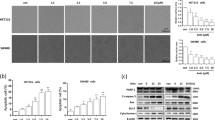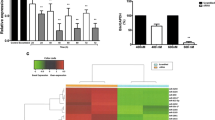Abstract
Tumor necrosis factor-α-inducible protein 8 (TNFAIP8) is the first discovered oncogenic and an anti-apoptotic member of a conserved TNFAIP8 or TIPE family of proteins. TNFAIP8 mRNA is induced by NF-kB, and overexpression of TNFAIP8 has been correlated with poor prognosis in many cancers. Downregulation of TNFAIP8 expression has been associated with decreased pulmonary colonization of human tumor cells, and enhanced sensitivities of tumor xenografts to radiation and docetaxel. Here we have investigated the effects of depletion of TNFAIP8 on the mRNA, microRNA and protein expression profiles in prostate and breast cancers and melanoma. Depending on the tumor cell type, knockdown of TNFAIP8 was found to be associated with increased mRNA expression of several antiproliferative and apoptotic genes (e.g., IL-24, FAT3, LPHN2, EPHA3) and fatty acid oxidation gene ACADL, and decreased mRNA levels of oncogenes (e.g., NFAT5, MALAT1, MET, FOXA1, KRAS, S100P, OSTF1) and glutamate transporter gene SLC1A1. TNFAIP8 knockdown cells also exhibited decreased expression of multiple onco-proteins (e.g., PIK3CA, SRC, EGFR, IL5, ABL1, GAP43), and increased expression of the orphan nuclear receptor NR4A1 and alpha 1 adaptin subunit of the adaptor-related protein complex 2 AP2 critical to clathrin-mediated endocytosis. TNFAIP8-centric molecules were found to be predominately implicated in the hypoxia-inducible factor-1α (HIF-1α) signaling pathway, and cancer and development signaling networks. Thus TNFAIP8 seems to regulate the cell survival and cancer progression processes in a multifaceted manner. Future validation of the molecules identified in this study is likely to lead to new subset of molecules and functional determinants of cancer cell survival and progression.
Access this chapter
Tax calculation will be finalised at checkout
Purchases are for personal use only
Similar content being viewed by others
References
Patel S, Wang FH, Whiteside TL, Kasid U (1997) Identification of seven differentially displayed transcripts in human primary and matched metastatic head and neck squamous cell carcinoma cell lines: implications in metastasis and/or radiation response. Oral Oncol 33:197–203
Kumar D, Whiteside TL, Kasid U (2000) Identification of a novel tumor necrosis factor-alpha-inducible gene, SCC-S2, containing the consensus sequence of a death effector domain of fas-associated death domain-like interleukin- 1beta-converting enzyme-inhibitory protein. J Biol Chem 275:2973–2978
Zhang Z, Liang X, Gao L et al (2015) TIPE1 induces apoptosis by negatively regulating Rac1 activation in hepatocellular carcinoma cells. Oncogene 34:2566–2574
Sun H, Gong S, Carmody RJ et al (2008) TIPE2, a negative regulator of innate and adaptive immunity that maintains immune homeostasis. Cell 133:415–426
Gus-Brautbar Y, Johnson D, Zhang L et al (2012) The anti-inflammatory TIPE2 is an inhibitor of the oncogenic Ras. Mol Cell 45:610–618
Fayngerts SA, Wu J, Oxley CL et al (2014) TIPE3 is the transfer protein of lipid second messengers that promote cancer. Cancer Cell 26:465–478
Lou Y, Liu S (2011) The TIPE (TNFAIP8) family in inflammation, immunity, and cancer. Mol Immunol 49:4–7
Zhang X, Wang J, Fan C et al (2009) Crystal structure of TIPE2 provides insights into immune homeostasis. Nat Struct Mol Biol 16:89–90
Horrevoets AJ, Fontijn RD, van Zonneveld AJ et al (1999) Vascular endothelial genes that are responsive to tumor necrosis factor-alpha in vitro are expressed in atherosclerotic lesions, including inhibitor of apoptosis protein-1, stannin, and two novel genes. Blood 93:3418–3431
You Z, Ouyang H, Lopatin D et al (2001) Nuclear factor-kappa B-inducible death effector domain-containing protein suppresses tumor necrosis factor-mediated apoptosis by inhibiting caspase-8 activity. J Biol Chem 276:26398–26404
Kumar D, Gokhale P, Broustas C et al (2004) Expression of SCC-S2, an antiapoptotic molecule, correlates with enhanced proliferation and tumorigenicity of MDA-MB 435 cells. Oncogene 23:612–616
Zhang C, Chakravarty D, Sakabe I et al (2006) Role of SCC-S2 in experimental metastasis and modulation of VEGFR-2, MMP-1, and MMP-9 expression. Mol Ther 13:947–955
Zhang C, Kallakury BV, Ross JS et al (2013) The significance of TNFAIP8 in prostate cancer response to radiation and docetaxel and disease recurrence. Int J Cancer 133:31–42
Day TF (2015) Effects of TNFAIP8 knockdown on EGFR and IGF-1R signaling and cytotoxicities of targeted drugs in non-small cell lung cancer cells. Ph.D. Dissertation submitted to the Faculty of the Graduate School of Arts and Sciences of Georgetown University
Zhang LJ, Liu X, Gafken PR et al (2009) A chicken ovalbumin upstream promoter transcription factor I (COUP-TFI) complex represses expression of the gene encoding tumor necrosis factor alpha-induced protein 8 (TNFAIP8). J Biol Chem 284:6156–6168
Wang Y, Hayakawa J, Long F et al (2005) “Promoter array” studies identify cohorts of genes directly regulated by methylation, copy number change, or transcription factor binding in human cancer cells. Ann N Y Acad Sci 1058:162–185
Chakravarty D (2007) Role of SCC-S2 in breast cancer cell proliferation and invasion. Ph.D. Dissertation submitted to the Faculty of the Graduate School of Arts and Sciences of Georgetown University
Dong QZ, Zhao Y, Liu Y et al (2010) Overexpression of SCC-S2 correlates with lymph node metastasis and poor prognosis in patients with non-small-cell lung cancer. Cancer Sci 101:1562–1569
Liu K, Qin CK, Wang ZY et al (2012) Expression of tumor necrosis factor-alpha-induced protein 8 in pancreas tissues and its correlation with epithelial growth factor receptor levels. Asian Pac J Cancer Prev 13:847–850
Duan D, Zhu YQ, Guan LL et al (2014) Upregulation of SCC-S2 in immune cells and tumor tissues of papillary thyroid carcinoma. Tumour Biol 35:4331–4337
Eisele L, Klein-Hitpass L, Chatzimanolis N et al (2007) Differential expression of drug-resistance-related genes between sensitive and resistant blasts in acute myeloid leukemia. Acta Haematol 117:8–15
Laliberté B, Wilson AM, Nafisi H et al (2010) TNFAIP8: a new effector for Galpha(i) coupling to reduce cell death and induce cell transformation. J Cell Physiol 225:865–874
Srivastava M, Eidelman O, Jozwik C et al (2006) Serum proteomic signature for cystic fibrosis using an antibody microarray platform. Mol Genet Metab 87:303–310
Jozwik CE, Pollard HB, Srivastava M et al (2012) Antibody microarrays: analysis of cystic fibrosis. Methods Mol Biol 23:179–200
Huang D, Li T, Li X et al (2014) HIF-1-mediated suppression of acyl-CoA dehydrogenases and fatty acid oxidation is critical for cancer progression. Cell Rep 8:1930–1942
Vinciguerra M, Sgroi A, Veyrat-Durebex C et al (2009) Unsaturated fatty acids inhibit the expression of tumor suppressor phosphatase and tensin homolog (PTEN) via microRNA-21 upregulation in hepatocytes. Hepatology 49:1176–1184
Hu H, Takano N, Xiang L et al (2014) Hypoxia-inducible factors enhance glutamate signaling in cancer cells. Oncotarget 5:8853–8868
Liu ZG, Smith SW, McLaughlin KA et al (1994) Apoptotic signals delivered through the T-cell receptor of a T-cell hybrid require the immediate-early gene nur77. Nature 367:281–284
Lin B, Kolluri SK, Lin F et al (2004) Conversion of Bcl-2 from protector to killer by interaction with nuclear orphan receptor Nur77/TR3. Cell 116:527–540
Mullican SE, Zhang S, Konopleva M et al (2007) Abrogation of nuclear receptors Nr4a3 and Nr4a1 leads to development of acute myeloid leukemia. Nat Med 13:730–735
Zhou F, Drabsch Y, Dekker TJA et al (2014) Nuclear receptor NR4A1 promotes breast cancer invasion and metastasis by activating TGF-β signaling. Nat Commun 5:3388. doi:10.1038/ncomms4388
Wenzl K, Troppan K, Neumeister P, Deutsch AJ (2015) The nuclear orphan receptor NR4A1 and NR4A3 as tumor suppressors in hematologic neoplasms. Curr Drug Targets 16:38–46
Hanna RN, Cekic C, Sag D et al (2015) Patrolling monocytes control tumor metastasis to the lung. Science 350:985–990
Höning S, Ricotta D, Krauss M et al (2005) Phosphatidylinositol-(4,5)-bisphosphate regulates sorting signal recognition by the clathrin-associated adaptor complex AP2. Mol Cell 18:519–531
Traub LM (2009) Tickets to ride: selecting cargo for clathrin-regulated internalization. Nat Rev Mol Cell Biol 10:583–596
McMahon HT, Boucrot E (2011) Molecular mechanism and physiological functions of clathrin-mediated endocytosis. Nat Rev Mol Cell Biol 12:517–533
Kelly BT, Graham SC, Liska N et al (2014) AP2 controls clathrin polymerization with a membrane-activated switch. Science 345:459–463
Tong J, Taylor P, Moran MF (2014) Proteomic analysis of the epidermal growth factor receptor (EGFR) interactome and post-translational modifications associated with receptor endocytosis in response to EGF and stress. Mol Cell Proteomics 13:1644–1658
Shevde LA, Samant RS, Paik JC et al (2006) Osteopontin knockdown suppresses tumorigenicity of human metastatic breast carcinoma, MDA-MB-435. Clin Exp Metastasis 23:123–133
Acknowledgements
Timothy F. Day, Rajshree R. Mewani, and Joshua Starr contributed equally to this work. This work was supported by grants from the National Institutes of Health (CA68322, CA74175) and Department of Defense (PC074171). TFD was supported, in part, by predoctoral fellowship award from the Department of Defense (W81XWH-10-1-0107). LM2-4175 cells were a gift from Dr. Joan Massagué. Portions of the work presented in this chapter were carried out by TFD and DC toward their Ph.D. dissertations. UNK is a coinventor on patent application, “Anti-apoptotic gene SCC-S2 and diagnostic and therapeutic uses thereof,” (US 12/858,360). Several cell lines were obtained from the Tissue Culture Shared Resource of the Georgetown Lombardi Comprehensive Cancer Center. The RNA array and microRNA array studies were performed using the Genomics and Epigenomics Shared Resource of the Georgetown Lombardi Comprehensive Cancer Center. All shared resources were supported by the NIH Grant P30-CA51008.
Author information
Authors and Affiliations
Corresponding author
Editor information
Editors and Affiliations
Rights and permissions
Copyright information
© 2017 Springer Science+Business Media New York
About this protocol
Cite this protocol
Day, T.F. et al. (2017). Transcriptome and Proteome Analyses of TNFAIP8 Knockdown Cancer Cells Reveal New Insights into Molecular Determinants of Cell Survival and Tumor Progression. In: Kasid, U., Clarke, R. (eds) Cancer Gene Networks. Methods in Molecular Biology, vol 1513. Humana Press, New York, NY. https://doi.org/10.1007/978-1-4939-6539-7_7
Download citation
DOI: https://doi.org/10.1007/978-1-4939-6539-7_7
Published:
Publisher Name: Humana Press, New York, NY
Print ISBN: 978-1-4939-6537-3
Online ISBN: 978-1-4939-6539-7
eBook Packages: Springer Protocols




